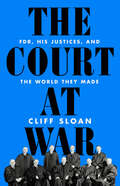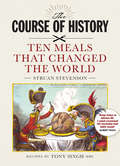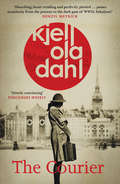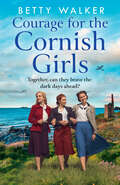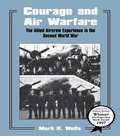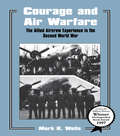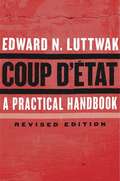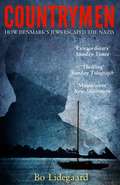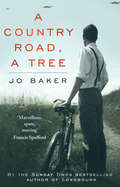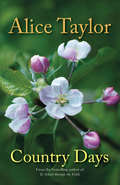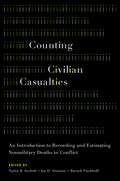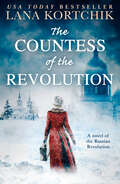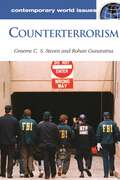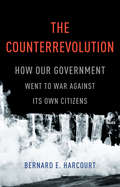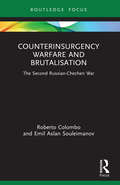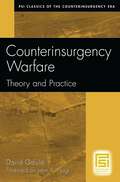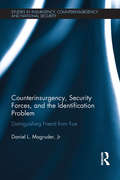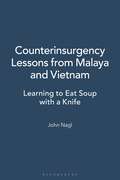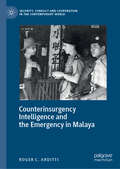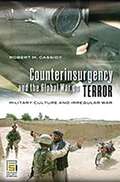- Table View
- List View
The Court at War: FDR, His Justices, and the World They Made
by Cliff SloanThe inside story of how one president forever altered the most powerful legal institution in the country—with consequences that endure today By the summer of 1941, in the ninth year of his presidency, Franklin Roosevelt had molded his Court. He had appointed seven of the nine justices—the most by any president except George Washington—and handpicked the chief justice. But the wartime Roosevelt Court had two faces. One was bold and progressive, the other supine and abject, cowed by the charisma of the revered president. The Court at War explores this pivotal period. It provides a cast of unforgettable characters in the justices—from the mercurial, Vienna-born intellectual Felix Frankfurter to the Alabama populist Hugo Black; from the western prodigy William O. Douglas, FDR&’s initial pick to be his running mate in 1944, to Roosevelt&’s former attorney general and Nuremberg prosecutor Robert Jackson. The justices&’ shameless capitulation and unwillingness to cross their beloved president highlight the dangers of an unseemly closeness between Supreme Court justices and their political patrons. But the FDR Court&’s finest moments also provided a robust defense of individual rights, rights the current Court has put in jeopardy. Sloan&’s intimate portrait is a vivid, instructive tale for modern times.
The Course of History: Ten Meals that Changed the World
by Struan StevensonMany decisions which have had enormous historical consequences have been made over the dinner table, and have been accompanied (and perhaps influenced) by copious amounts of food and wine. In The Course of History Struan Stevenson brings to life ten such moments, exploring the personalities, the issues and of course the food which helped shape the course of history.From the claret consumed on the eve of the Battle of Culloden, through the dinners which decided the fates of George Washington, Archduke Ferdinand and Adolf Hitler, to the diplomatic feasts that decided future relations with Russia, China and the Middle East, each chapter covers every detail, character, decision and morsel which decided the course of history.
The Courier
by Kjell Ola DahlThe international bestselling godfather of Nordic Noir takes on one of the most horrific periods of modern history, in a stunning standalone thriller … NUMBER ONE BESTSELLER‘The Courier is a stylish stand-alone thriller from the godfather of Scandi noir … Ola Dahl ratchets up the tension from the first pages and never lets go’ The Times‘Cleverly braiding together past and present, the who and why of murder and betrayal are unpicked. The detail is impressive’ Daily MailIn 1942, Jewish courier Ester is betrayed, narrowly avoiding arrest by the Gestapo. In a great haste, she escapes to Sweden, saving herself. Her family in Oslo, however, is deported to Auschwitz. In Stockholm, Ester meets the resistance hero, Gerhard Falkum, who has left his little daughter and fled both the Germans and allegations that he murdered his wife, Åse, who helped Ester get to Sweden. Their burgeoning relationship ends abruptly when Falkum dies in a fire.And yet, twenty-five years later, Falkum shows up in Oslo. He wants to reconnect with his daughter. But where has he been, and what is the real reason for his return? Ester stumbles across information that forces her to look closely at her past, and to revisit her war-time training to stay alive…Written with Dahl's trademark characterization and elegant plotting, The Courier sees the hugely respected godfather of Nordic Noir at his best, as he takes on one of the most horrific periods of modern history, in an exceptional, shocking thriller.‘Absorbing, heart-rending and perfectly plotted. Kjell Ola Dahl’s The Courier passes seamlessly from the present to the dark past of WWII. Fabulous!’ Denzil Meyrick‘Skilfully juggling three Oslo timelines — in 1942, 1967 and 2015 — Dahl starts his story with Germany’s occupation of Norway and the work of those who tried to resist, then brings his characters forward to a post-war unravelling of what really happened in those dangerous days — and the traumatic rewriting of personal stories’ The Times Crime Club‘The Courier is very good on the socio-political situation of the time, the relationship between Norway and neutral neighbour Sweden. This is a gritty but ultimately uplifting story. Superbly translated by Don Bartlett’ NB Magazine‘A fascinating, intricate, provocative read, set in motion by events in 1942, and brilliantly highlighting human need and emotions … ‘The Courier’ sent a shiver coursing through me, it is a truly eloquent and rewarding tale, and oh that ending!’ LoveReading‘Written with Dahl’s trademark characterisation and clever plotting, The Courier sees one of Norway’s most critically acclaimed authors at his best … This stunning and compelling wartime thriller is reminiscent of the writing of John Le Carré and William Boyd’ New Books Magazine‘Utterly convincing’ Publishers Weekly‘Kjell Ola Dahl’s novels are superb. If you haven’t read one, you need to – right now’ William Ryan‘More than gripping’ European Literature Network‘The perfect example of why Nordic Noir has become such a popular genre’ Reader’s Digest‘It all comes together, of course, in the kind of masterful, detailed plotting that Dahl is known for … the power of The Courier is how Dahl has given a complex, human face to such an inhuman tragedy’ Crime Fiction Lover‘Atmospheric thriller with lots of great twists and loved the scandi wartime story in particular. Gripping will be recommending to readers’ Edgy Books
The Courage To Love Her Army Doc: The Army Doc's Baby Bombshell / Taming Her Navy Doc / The Courage To Love Her Army Doc (Mills And Boon Medical Ser.)
by Karin BaineTaking chances Dr Joe Braden took the posting as locum on a remote Fijian island to escape his memories. But he finds the solace he seeks in the unlikeliest of places…the arms of captivating Dr Emily Clifford.
Courage for the Cornish Girls (The Cornish Girls Series #3)
by Betty WalkerApril 1942. Enemy gunfire on Penzance beach brings the Cornish Girls rushing to the rescue…
Courage and Air Warfare: The Aircrew Experience in World War II
by Mark K. WellsColonel Wells investigates the nature of aerial warfare and the men who took part. The book analyzes aircrew selection, reaction to combat, adaptability to stress, morale, leadership and combat effectiveness, and compares the efforts of the US Eighth Air Force and RAF Bomber Command.
Courage and Air Warfare: The Allied Aircrew Experience in the Second World War (Studies in Air Power #Vol. 2)
by Mark K. WellsColonel Wells investigates the nature of aerial warfare and the men who took part. The book analyzes aircrew selection, reaction to combat, adaptability to stress, morale, leadership and combat effectiveness, and compares the efforts of the US Eighth Air Force and RAF Bomber Command.
Courage and Air Warfare: The Allied Aircrew Experience in the Second World War (Studies in Air Power)
by Mark K. WellsColonel Wells investigates the nature of aerial warfare and the men who took part. The book analyzes aircrew selection, reaction to combat, adaptability to stress, morale, leadership and combat effectiveness, and compares the efforts of the US Eighth Air Force and RAF Bomber Command.
Coup d'État: A Practical Handbook, Revised Edition
by Edward N. LuttwakEdward Luttwak’s shocking 1968 handbook showed, step-by-step, how governments could be overthrown and inspired anti-coup precautions around the world. In addition to these instructions, his revised handbook offers a new way of looking at political power—one that considers the vulnerability of stable democracies after prolonged economic distress.
Coup d'État
by Edward N. LuttwakEdward Luttwak’s shocking 1968 handbook showed, step-by-step, how governments could be overthrown and inspired anti-coup precautions around the world. In addition to these instructions, his revised handbook offers a new way of looking at political power—one that considers the vulnerability of stable democracies after prolonged economic distress.
Countrymen: The Untold Story of How Denmark's Jews Escaped the Nazis
by Bo LidegaardThe rescue of the Danish Jews from Nazi persecution in October 1943 is a unique exception to the tragic history of the Holocaust. Over fourteen harrowing days, as they were helped, hidden and protected by ordinary people who spontaneously rushed to save their fellow citizens, an incredible 7,742 out of 8,200 Jewish refugees were smuggled out all along the coast - on ships, schooners, fishing boats, anything that floated - to Sweden. Now, for the first time, Bo Lidegaard brings together decades of research and new evidence, including unpublished diaries and documents of families forced to run for safety and of those who courageously came to their aid, to tell this story of ordinary glory, of simple courage and moral fortitude that shines out in the midst of the terrible history of the twentieth century and demonstrates how it was possible for a small and fragile democracy to stand against the Third Reich.
A Country Road, A Tree
by Jo BakerBY THE SUNDAY TIMES BESTSELLING AUTHOR OF LONGBOURNSHORTLISTED FOR THE WALTER SCOTT PRIZE FOR HISTORICAL FICTION 2017SHORTLISTED FOR THE JAMES TAIT BLACK PRIZE 2017 'Skilful . . . daring . . . extraordinary' The Guardian'A fascinating fictional account of Samuel Beckett's wartime years' IAN RANKIN'Beautifully written, empathetic and unflinching, it is very, very good' Daily Mail'Marvellous, spare, moving' FRANCIS SPUFFORD'Insightful . . . beautifully paced . . . authentic’ The Irish TimesParis, 1939: The pavement rumbles with the footfall of Nazi soldiers marching along the Champs Elysees. A young writer, recently arrived from Ireland to make his mark, smokes one last cigarette with his lover before the city they know is torn apart. Soon, he will put is own life and those of his loved ones in mortal danger by joining the Resistance...Spies, artists, deprivation, danger and passion: this is a story of life at the edges of human experience, and of how one man came to translate it all into art.Sunday Express Book of the MonthPraise for Jo Baker's LONGBOURN:'Intoxicating' Guardian'Engrossing' Sunday Times'Audacious' New York Times
Country Days (Reminiscence Ser.)
by Alice TaylorMemoir from the bestselling author of To School Through the Fields who has been described by The Observer as 'Ireland's Laurie Lee...a chronicler of fading village life and rural rituals who sells and sells'. In this collection she takes her readers along the byways of Ireland and into the heart of the country. In stories by turn comic and poignant, she explores the character of family and friends, testing the bonds of concern and kindness which hold people together.
Counting Civilian Casualties Ssp C: An Introduction To Recording And Estimating Nonmilitary Deaths In Conflict
by Taylor B. Seybolt Jay D. Aronson Baruch FischhoffThe Countess of the Revolution
by Lana Kortchik‘Everything I love about historical fiction and more.’ Reader review ⭐⭐⭐⭐⭐ Russia, 1917
Counterterrorism: A Reference Handbook (Contemporary World Issues)
by Graeme Colin Steven Rohan Kumar GunaratnaAn up-to-date analysis of the wave of terrorism in the post-Cold War era and the ways in which states and societies are responding.Counter-Terrorism: A Reference Handbook outlines the threat of terrorism and ways to combat it. Written by two expert insiders in the field, this extensive examination surveys a wide range of diverse terrorist groups from the Provisional Irish Republican Army (PIRA) to Al Qaeda. It shows how key trends and patterns in domestic and international terrorism such as suicide bombings require counter strategies and tactics including surveillance and reconnaissance.Case studies of terrorist organizations in Europe, Asia, Africa, Latin America, the Balkans, and the Caucasus, and profiles of terrorists like Khalid Sheikh Mohommad, alias Mokhtar (The Brain), who masterminded the Al Qaeda attack on 9/11, illustrate the growing network of groups and leaders harnessing the forces of globalization. Finally, the authors suggest lthat no single state can act effectively on its own to confront terrorism--instead, a wide range of strategies needs to be adopted by all.
The Counterrevolution: How Our Government Went To War Against Its Own Citizens
by Bernard E. HarcourtMilitarized police officers with tanks and drones. Pervasive government surveillance and profiling. Social media that distract and track us. All of these, contends Bernard E. Harcourt, are facets of a new and radical governing paradigm in the United States -- one rooted in the modes of warfare originally developed to suppress anticolonial revolutions and, more recently, to prosecute the war on terror. The Counterrevolution is a penetrating and disturbing account of the rise of counterinsurgency, first as a military strategy but increasingly as a way of ruling ordinary Americans. Harcourt shows how counterinsurgency's principles -- bulk intelligence collection, ruthless targeting of minorities, pacifying propaganda -- have taken hold domestically despite the absence of any radical uprising. This counterrevolution against phantom enemies, he argues, is the tyranny of our age. Seeing it clearly is the first step to resisting it effectively.
Counterinsurgency Warfare and Brutalisation: The Second Russian-Chechen War (Cass Military Studies)
by Roberto Colombo Emil Aslan SouleimanovThis book offers the first analysis of the brutalisation paradigm in counter-insurgency warfare. Minimising the use of force and winning over the population’s opinion is said to be the cornerstone of success in modern counterinsurgency (COIN). Yet, this tells only one side of the story. Drawing upon primary data collected during interviews with eyewitnesses of the Second Russian-Chechen War, as well as from secondary sources, this book is the first to offer a detailed analysis of the long-neglected logic underpinning brutalisation-centred COIN campaigns. It offers a comprehensive systematisation of the brutalisation paradigm and challenges the widespread assumption of brutalisation as an underperforming paradigm of COIN warfare. It shows that, although appalling, brutalisation-centred measures can deliver success. The book also outlines a stigmatised yet widely deployed set of COIN measures and provides critical insights into how Western military blueprints can be improved without compromising important moral and ethical requirements. This book will be of much interest to students of counterinsurgency, military and strategic studies, Russian politics, and International Relations.
Counterinsurgency Warfare and Brutalisation: The Second Russian-Chechen War (Cass Military Studies)
by Roberto Colombo Emil Aslan SouleimanovThis book offers the first analysis of the brutalisation paradigm in counter-insurgency warfare. Minimising the use of force and winning over the population’s opinion is said to be the cornerstone of success in modern counterinsurgency (COIN). Yet, this tells only one side of the story. Drawing upon primary data collected during interviews with eyewitnesses of the Second Russian-Chechen War, as well as from secondary sources, this book is the first to offer a detailed analysis of the long-neglected logic underpinning brutalisation-centred COIN campaigns. It offers a comprehensive systematisation of the brutalisation paradigm and challenges the widespread assumption of brutalisation as an underperforming paradigm of COIN warfare. It shows that, although appalling, brutalisation-centred measures can deliver success. The book also outlines a stigmatised yet widely deployed set of COIN measures and provides critical insights into how Western military blueprints can be improved without compromising important moral and ethical requirements. This book will be of much interest to students of counterinsurgency, military and strategic studies, Russian politics, and International Relations.
Counterinsurgency Warfare: Theory and Practice (PSI Classics of the Counterinsurgency Era)
by David GalulaThis volume in the Praeger Security International (PSI) series Classics of the Counterinsurgency Era defines the laws of insurgency and outlines the strategy and tactics to combat such threats. Drawn from the observations of a French officer, David Galula, who witnessed guerrilla warfare on three continents, the book remains relevant today as American policymakers, military analysts, and members of the public look to the counterinsurgency era of the 1960s for lessons to apply to the current situation in Iraq and Afghanistan. With a new foreword by John A. Nagl, author of Counterinsurgency Lessons from Malaya and Vietnam (Praeger, 2002).
Counterinsurgency, Security Forces, and the Identification Problem: Distinguishing Friend From Foe (Studies in Insurgency, Counterinsurgency and National Security)
by Daniel L. Magruder, JrThis book presents a theory and empirical evidence for how security forces can identify militant suspects during counterinsurgency operations. A major oversight on the part of academics and practitioners has been to ignore the critical antecedent issue common to persuasion and coercion counterinsurgency (COIN) approaches: distinguishing friend from foe. This book proposes that the behaviour of security forces influences the likelihood of militant identification during a COIN campaign, and argues that security forces must respect civilian safety in order to create a credible commitment to facilitate collaboration with a population. This distinction is important as conventional wisdom has wrongly assumed that the presence of security forces confers control over terrain or influence over a population. Collaboration between civilian and government actors is the key observable indicator of support in COIN. Paradoxically, this theory accounts for why and how increased risk to government forces in the short term actually improves civilian security in the long run. Counterinsurgency, Security Forces, and the Identification Problem draws on three case studies: the Huk Rebellion in the Philippines post-World War II; Marines Corps’ experiences in Vietnam through the Combined Action Program; and Special Operations activities in Iraq after 2003. For military practitioners, the work illustrates the critical precursor to establishing "security" during counterinsurgency operations. The book also examines the role and limits of modern technology in solving the identification problem. This book will be of interest to students of counterinsurgency, military history, strategic studies, US foreign policy, and security studies in general.
Counterinsurgency, Security Forces, and the Identification Problem: Distinguishing Friend From Foe (Studies in Insurgency, Counterinsurgency and National Security)
by Daniel L. Magruder, JrThis book presents a theory and empirical evidence for how security forces can identify militant suspects during counterinsurgency operations. A major oversight on the part of academics and practitioners has been to ignore the critical antecedent issue common to persuasion and coercion counterinsurgency (COIN) approaches: distinguishing friend from foe. This book proposes that the behaviour of security forces influences the likelihood of militant identification during a COIN campaign, and argues that security forces must respect civilian safety in order to create a credible commitment to facilitate collaboration with a population. This distinction is important as conventional wisdom has wrongly assumed that the presence of security forces confers control over terrain or influence over a population. Collaboration between civilian and government actors is the key observable indicator of support in COIN. Paradoxically, this theory accounts for why and how increased risk to government forces in the short term actually improves civilian security in the long run. Counterinsurgency, Security Forces, and the Identification Problem draws on three case studies: the Huk Rebellion in the Philippines post-World War II; Marines Corps’ experiences in Vietnam through the Combined Action Program; and Special Operations activities in Iraq after 2003. For military practitioners, the work illustrates the critical precursor to establishing "security" during counterinsurgency operations. The book also examines the role and limits of modern technology in solving the identification problem. This book will be of interest to students of counterinsurgency, military history, strategic studies, US foreign policy, and security studies in general.
Counterinsurgency Lessons from Malaya and Vietnam: Learning to Eat Soup with a Knife (Non-ser.)
by John NaglArmies are invariably accused of preparing to fight the last war. Nagl examines how armies learn during the course of conflicts for which they are initially unprepared in organization, training, and mindset. He compares the development of counterinsurgency doctrine and practice in the Malayan Emergency from 1948-1960 with that developed in the Vietnam Conflict from 1950-1975, through use of archival sources and interviews with participants in both conflicts. In examining these two events, he argues that organizational culture is the key variable in determining the success or failure of attempts to adapt to changing circumstances.Differences in organizational culture is the primary reason why the British Army learned to conduct counterinsurgency in Malaya while the American Army failed to learn in Vietnam. The American Army resisted any true attempt to learn how to fight an insurgency during the course of the Vietnam Conflict, preferring to treat the war as a conventional conflict in the tradition of the Korean War or World War II. The British Army, because of its traditional role as a colonial police force and the organizational characteristics that its history and the national culture created, was better able to quickly learn and apply the lessons of counterinsurgency during the course of the Malayan Emergency. This is the first study to apply organizational learning theory to cases in which armies were engaged in actual combat.
Counterinsurgency Intelligence and the Emergency in Malaya (Security, Conflict and Cooperation in the Contemporary World)
by Roger C. ArdittiThis book examines the full range of counterinsurgency intelligence during the Malayan Emergency. It explores the involvement of the Security Service, the Joint Intelligence Committee (Far East), the Malayan Security Service, Special Branch and wider police service, and military intelligence, to examine how British and Malayan authorities tackled the insurgent challenge posed by the Malayan Communist Party. This study assesses the nature of the intelligence apparatus prior to the declaration of emergency in 1948 and considers how officials attempted to reconstruct the intelligence structures in the Far East after the surrender of the Japanese in 1945. These plans were largely based upon the legacy of the Second World War but quickly ran into difficultly because of ill-defined remits and personality clashes. Nevertheless, officials did provide prescient warning of the existential threat posed by the Malayan Communist Party from the earliest days of British reoccupation of Malaya. Once a state of emergency had been declared, officials struggled to find the right combination of methods, strategy and management structures to eliminate the threat posed by the Communist insurgents. This book argues that the development of an effective counterinsurgency intelligence strategy involved many more organisations than just Special Branch. It was a multifaceted, dynamic effort that took far longer and was more problematic than previous accounts suggest. The Emergency remains central to counterinsurgency theory and thus this wide-ranging analysis sheds crucial light not only on the period, but on contemporary doctrine and security practices today.
Counterinsurgency and the Global War on Terror: Military Culture and Irregular War (Praeger Security International)
by Robert M. CassidySince September 2001, the United States has waged what the government initially called the global war on terrorism (GWOT). Beginning in late 2005 and early 2006, the term Long War began to appear in U.S. security documents such as the National Security Council's National Strategy for Victory in Iraq and in statements by the U.S. Secretary of Defense and the Chairman of the JCS. The description Long War—unlimited in time and space and continuing for decades—is closer to reality and more useful than GWOT.Colonel Robert Cassidy argues that this protracted struggle is more correctly viewed as a global insurgency and counterinsurgency. Al Qaeda and its affiliates, he maintains, comprise a novel and evolving form of networked insurgents who operate globally, harnessing the advantages of globalization and the information age. They employ terrorism as a tactic, subsuming terror within their overarching aim of undermining the Western-dominated system of states. Placing the war against al Qaeda and its allied groups and organizations in the context of a global insurgency has vital implications for doctrine, interagency coordination, and military cultural change-all reviewed in this important work.Cassidy combines the foremost maxims of the most prominent Western philosopher of war and the most renowned Eastern philosopher of war to arrive at a threefold theme: know the enemy, know yourself, and know what kind of war you are embarking upon. To help readers arrive at that understanding, he first offers a distilled analysis of al Qaeda and its associated networks, with a particular focus on ideology and culture. In subsequent chapters, he elucidates the challenges big powers face when they prosecute counterinsurgencies, using historical examples from Russian, American, British, and French counterinsurgent wars before 2001. The book concludes with recommendations for the integration and command and control of indigenous forces and other agencies.
